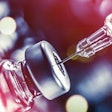
A blood test that measures SARS-CoV-2 RNA when patients are admitted to the hospital with COVID-19 symptoms can be a powerful diagnostic tool to predict how severe their disease will be, according to a study published in Clinical Infectious Diseases on August 28. Patients without viral RNA in their blood have a good chance at rapid recovery, concluded researchers from Karolinska Institutet and Danderyd Hospital.
With the original SARS-CoV virus, high serum viral load and detection of the virus at multiple sites were predictive of adverse clinical outcomes. With SARS-CoV-2, increased oropharyngeal (throat) viral loads have been associated with age. Disease severity has been suggested to be correlated to SARS-CoV-2 RNA detected in serum. The inability to control viral replication can lead to spread of infection to multiple organs, possibly causing severe disease and driving excessive inflammatory reactions.
The authors of the current paper suggested that detection of viral RNA in blood serum may therefore be an early prognostic marker that is simpler to use compared to other complex risk-scoring systems (risk nomogram, COVID-GRAM). Therefore, they evaluated the prognostic value of detecting serum SARS-CoV-2 RNA with a commonly available method (reverse transcription polymerase chain reaction [RT-PCR] using a fully automated or in-house method of RNA extraction on Roche Diagnostics analyzers).
In the retrospective study, blood samples were taken from patients with "confirmed" COVID-19 within three days of admission at Danderyd Hospital in Sweden between April 10 and June 30. All patients that entered the hospital during the study period with COVID-19-like symptoms were screened for SARS-CoV-2 in airway samples by PCR assays. Patients with positive results were classified as a "confirmed" diagnosis.
In all, 167 patients with "confirmed" COVID-19 were admitted during the study period and were tested for SARS-CoV-2 RNA in serum. SARS-CoV-2 was detected in the serum of 37% of patients. Of the 61 patients who tested positive, 25% died within 28 days of blood sampling.
This compares to only a 3% death rate in patients who did not test positive for SARS-CoV-2 RNA in the blood (3 of 106). In total, 44% of the PCR-positive group reached critical disease (care in the intensive care unit or death) compared to only 7% of patients who tested negative for serum SARS-CoV-2 RNA.
The presence of SARS-CoV-2 RNA in the serum increased with age, with a statistically significant increase in patients over the age of 60. This might be explained by a decreased ability to control viral replication that has been previously linked to severe disease.
In conclusion, the authors found a seven-fold increased risk of critical disease progression and an eight-fold increased risk of death when patients tested positive for SARS-CoV-2 RNA in blood serum. Of equal importance, not detecting SARS-CoV-2 RNA in serum denoted a high chance of an uncomplicated recovery.
"This readily available test allows us to identify patient groups at high or low risk of severe COVID-19, which enables us to better guide the treatment and monitoring of these patients," said lead author Dr. Karl Hagman, infectious diseases consultant at Danderyd Hospital and doctoral student at the Karolinska Institutet Department of Clinical Sciences at the same hospital, in a statement.



















